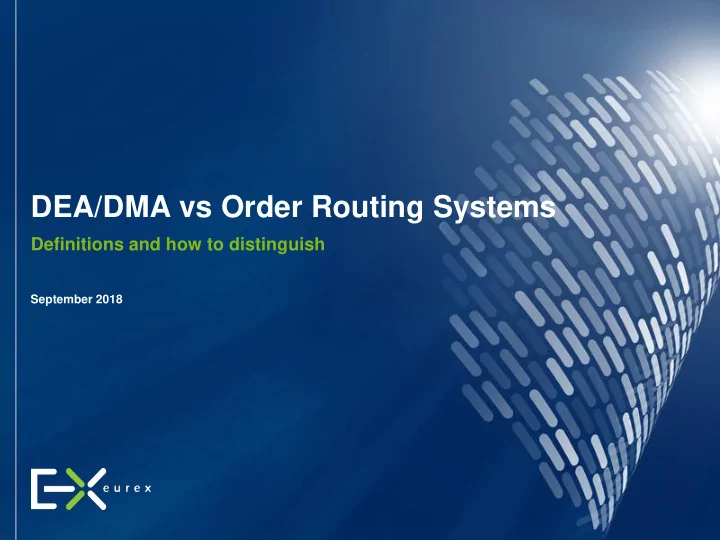

DEA/DMA vs Order Routing Systems Definitions and how to distinguish September 2018
September 2018 Electronic access definition under MiFID II / MiFIR DEA is only one possible way to electronically access venues and comprises Direct Market Access (DMA) and Sponsored Access (SA). Commission Delegated Order Routing System (ORS) Regulation (EU) No 2017/565 Arrangements that allow clients to transmit Recital (25) orders to an investment firm in an electronic “Therefore, arrangements where format, such as online brokerage client orders are intermediated Do not have the ability to determine the through electronic means by fraction of a second of order entry and the life time of orders members or participants of a trading venue such as online brokerage Eurex Eurex and arrangements where clients Exchange have direct electronic access to a Exchange DEA / DMA trading venue should be Where that person can exercise discretion distinguished.” regarding the exact fraction of a second of order entry and the lifetime of the order within that timeframe No arrangements for optimisation of order execution processes applied by the provider of DEA www.eurexchange.com 2
September 2018 DMA / DEA versus Order Routing System Provider (Eurex trading participant) ORS Clients cannot exercise discretion regarding the exact fraction of a second of Pre-trade controls according to RTS 6 order entry and the lifetime of the order prior and/or after the controls were performed (definition from Q12 of ESMA’s questions and answers as of Oct 3 rd , 2017 ). Perform checks to ensure conformity The provider has the right to change an order parameter without further notice (optimisation of execution) and reasonability (not defined in or The order could be delayed ( adding an unpredictable latency penalty ). MiFID II / MiFIR) User Technology (infrastructure) used to transfer the order: Eurex not a Owned and controlled by the provider Supervised by an admitted trader trading participant Exchange of Eurex Exchange DMA / DEA Pre-trade controls Clients exercise discretion regarding the exact fraction of a second of order according to RTS 6 entry and the lifetime of the order prior and/or after the pre-trade controls were performed (definition from the ESMA’s questions and answers ). The provider does not change an order parameter. The order is not artificially delayed (unpredictable latency penalty). Technology (infrastructure) used to transfer the order: For DMA the infrastructure is owned and controlled by the provider For SA the infrastructure is owned and controlled by another third party (infrastructure provider) The DEA provider has to keep control over the parameters of the pre-trade checks in all circumstances. www.eurexchange.com 3
September 2018 Set-up scenario Using different trader IDs to distinguish order flow Provider (Eurex trading participant) DMA / DEA client DMA User ID: DMA001 Eurex pre-trade checks Exchange undecided Eurex Client Exchange (DMA and ORS) ORS User ID: ORS001 „ losing controls “ pre-trade checks ORS client Client loses control over an order either by: Unpredictable latency penalties applied Functional changes to the order by An algo of the participant Human interaction www.eurexchange.com 4
Recommend
More recommend